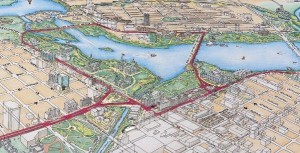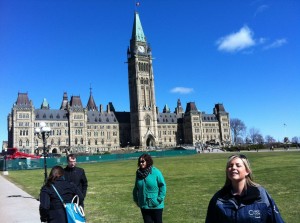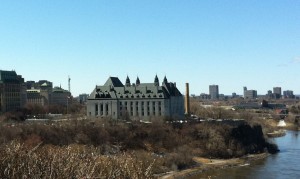Post Conference Review #1: Canadian Parliamentary Precinct
27 May 2013 – Alix Green
Editor’s note: HIstory@Work is pleased to bring you a series of eight reviews written about sites explored during the 2013 NCPH Annual Meeting in Ottawa, Ontario, published in The Public Historian on the Public History Commons.
The Canadian Parliamentary Precinct as Public History: Telling the Outside Story Walking Tour, April 17, 2013. NCPH Annual Meeting, Ottawa, Ontario, Canada. Creators: National Capital Commission; Tour leader: Mark Kristmanson, Director, Capital Interpretation, Commemoration and Public Art.
As a hybrid of policy professional and historian interested in the role of history in political processes, this tour was first in my shopping basket when I registered for the NCPH conference in Ottawa. For me, parliamentary buildings and districts hold a magnetic appeal, making any visit to a capital city a busman’s holiday. As Stefan Berger reminds us, historians are, necessarily, always engaged in comparison. Such tours are, therefore, an opportunity for public historians to place comparative thinking—a dimension that remains relatively unexplored in the field—at the forefront of our minds.
I should begin my comments by explaining that we weren’t taken on a standard tour of the precinct. Mark Kristmanson, Director of Capital Interpretation for the National Capital Commission (NCC), and his staff had thoughtfully put together what they termed a ‘meta-tour’: a combination of the historical interpretation itself, and an explanation of how visitor services are conceived and delivered. In other words, they knew their audience.
We walked down Lyon Street, under the “stripped-down art deco” arches of the Veterans’ Memorial Buildings to Wellington Street, part of the Confederation Boulevard: a ceremonial route that embraces the Ontario and Quebec shorelines of the Ottawa River (and itself an interesting public history concept). Following the Boulevard east, we were successively introduced to striking assemblages of architectural ideas about democracy, culture, and citizenship.

Part of the Confederation Boulevard map.
National Capital Commission.
Next, and on our left, the uncompromising “German/Italian Fascist” lines of Supreme Court came into view. The curved “Château”-style windowed roofs offer a notable contrast, and are attributed to the influence of the then Prime Minister, Mackenzie King, whose thirteen-year leadership (1935-1948) spanned the beginning of construction in 1939 and the first hearings in 1946.
Echoes of Edinburgh could be discerned in the stonework of government buildings, the cliff-top outlook making them all the more resonant for anyone who has seen images of the castle that presides over the Scottish capital. Central Block, the building in which the Senate and House of Commons meet, forms one side of a lawned quad, and features a clock tower unmistakably modelled on that which stands at the north end of the Palace of Westminster in London. As we stood there, a chime recognized across the world marked the hour on the day that Big Ben, the great bell housed in the Westminster tower, was silent for the funeral of former British Prime Minister, Margaret Thatcher. Visible from our vantage point were the round towers of the Château Laurier, distinct against the gothic lines of the East Block. These are the comments of an untrained eye, and the origin and mix of influences on the architecture of the Parliamentary Precinct would be an interesting addition to the tour. Partly inspired by this experience, I’m now developing a plan for comparative research on the architectural ideas of national capitals.
Comparative comments were, indeed, made by many of the participants about the openness of the area. We discussed with our guides the contested nature of the space: the arguments that had been made post-9/11 for cordoning off Parliament Hill and how those had been, thus far, resisted (camera surveillance being intense but invisible).

Central Block. Our guide explains about the on-going debates around security. (Photo courtesy
of Alix Green.)
Although the majority of visitors to Ottawa are Canadians, foreigners call in disproportionate numbers on the services of the NCC (around thirty per cent). This may be a feature that parliamentary precincts share; how many of us choose to visit the seats of government in our own countries, compared to the numbers of foreign tourists? Perhaps disillusionment with politics, and national politics in particular, is a factor. Do we view the buildings in which our elected representatives convene in terms of politics, but those which house foreign chambers as historical parts of their national heritage?
We were told about a two-year pilot program undertaken by visitor services, which had led to individuals, located at key points, being replaced by pairs of “roving” guides—resulting in a five-fold increase in engagements. Students recruited from local universities provide many of the guides during high season. The demands on them to be proactive with visitors, and to tailor their interactions to very diverse needs, call on a range of high-level skills as well as on historical knowledge: certainly a valuable training for future public historians.
I had downloaded the NCC Capital Tour app before I arrived and it was interesting to hear from Mark after the tour about how the approach has evolved over time. Initially designed to package material by length of tour required, a new version will organize it situationally: where am I now and where can I go next? The new Wi-Fi zone on the Hill has made the apps more popular. What may seem a minor point is actually a substantive one. Apps can be regarded as a “must-have,” engaging a new, smart-phone-obsessed audience, but then the usability of an app on the ground may be overlooked: can it be downloaded quickly (and therefore relatively cheaply)? How effective is it in tracking the user’s movement? Can relevant additional content on external websites be accessed efficiently (tourist information, public transport, restaurants and so on)? Free, reliable public Wi-Fi makes a difference (especially for international visitors) and the case for linking public history services to wider initiatives around economic development and urban renewal would seem worth exploring.
As historians, we may be focused on and concerned about “content,” and that’s certainly important (the NCC app helpfully offers different levels of detail). But it’s not the only issue, as my conversation with Mark made clear. How to assemble content appropriately for consumption, and thereby serve very different interests and priorities, may actually be the more problematic question. This discussion also points to the deep connections between history and geography, time and place. Can there be a fruitful dialogue between public history and “public geography?”
The Parliamentary Precinct “meta-tour” gave a thought-provoking insight into the work of integrating visitor services with historic interpretation. That we only managed to fit in about four stops is testament to the high level of engagement of the assembled participants. I would happily have devoted a much longer time to this tour, being so tantalizingly close to a whole array of buildings and monuments, but unable to investigate in more depth. That is no criticism of our guides, more the regret of a confessed enthusiast (both for high politics and the historic built environment). I would have welcomed more of a historical perspective on the site, the references encoded in its design and a sense of its place in the history of Canadian (and Commonwealth) politics. It may, however, be impossible to meet such a wide range of expectations in full, and I would certainly commend NCC for accommodating those of visitors to Ottawa so thoughtfully.
~ Alix Green , University of Hertfordshire, UK





tommy hilfiger メンズ